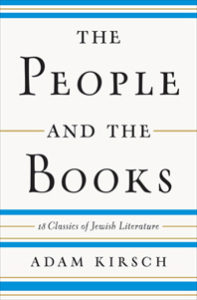 The brilliant Adam Kirsch has a new book out, and it’s a must-read for anyone who’s truly seeking to educate themselves in Jewish history and literature. Here’s the wrinkle: Unless you’ve already benefited from a pretty comprehensive Jewish education, The People and the Books will likely make you want to place on your own to-read list each of the 18 “classics of Jewish literature” that it analyzes. And since some of titles discussed—take the Zohar, for instance—total thousands of pages and require multiple volumes, that list is going to get much, much longer.
The brilliant Adam Kirsch has a new book out, and it’s a must-read for anyone who’s truly seeking to educate themselves in Jewish history and literature. Here’s the wrinkle: Unless you’ve already benefited from a pretty comprehensive Jewish education, The People and the Books will likely make you want to place on your own to-read list each of the 18 “classics of Jewish literature” that it analyzes. And since some of titles discussed—take the Zohar, for instance—total thousands of pages and require multiple volumes, that list is going to get much, much longer.
I’ve decided to begin with a less ambitious goal. Having read through Kirsch’s new book, and recognizing my own reading preferences, I’m going add to my tbr list only five of the titles discussed in The People and the Books. For now.
The five I’ve chosen:
The Book of Deuteronomy. I’m cheating a bit with this one, because, yes, I have already read sections of Deuteronomy. But now, primed with Kirsch’s knowledgeable yet accessible opening chapter, I want to return to it as a discrete work.
The Tsenerene: Maybe it has something to do with my own (mainly female) Jewish text-and-writing group. But I’m eager to spend some time with what Kirsch calls “the book that did most to connect Jewish women to Judaism’s traditional sources,” the Tsenerene, “which became such a standard text that it is sometimes referred to as ‘the Yiddish Women’s Bible.’ First published in the 1590s, the Tsenerene would go through more than two hundred editions, making it one of the most popular Yiddish books of all time.” (Judging from the bibliography Kirsch has appended, it looks as though the way I’ll get to this one is via The Weekly Midrash: Tz’enah Ur’enah, translated by Miriam Stark Zakon for Mesorah Publications.)
The Memoirs of Glückel of Hameln. Coupled for discussion with the Tsenerene in one chapter of People of the Books, this text wasn’t published until 1896, ggenerations after its author’s death in 1724. “By then,” Kirsch writes, “it was recognized as an indispensable document of the experience of Jewish women in Ashkenazi society—an experience that finds virtually no representation in classic Jewish literature.”
Old New Land by Theodor Herzl. Kirsch has prepared me not to expect a great literary novel here. But he has also convinced me that it’s an essential Jewish text, one which I, a self-identified Zionist, really must read.
Tevye the Dairyman by Sholem Aleichem. This one is here mainly because Kirsch has made me realize how much more there is to this work than the story I know from stage and screen.
Have any of you read this book yet? What are your responses to it?
 The brilliant Adam Kirsch has a new book out, and it’s a must-read for anyone who’s truly seeking to educate themselves in Jewish history and literature. Here’s the wrinkle: Unless you’ve already benefited from a pretty comprehensive Jewish education, The People and the Books will likely make you want to place on your own to-read list each of the 18 “classics of Jewish literature” that it analyzes. And since some of titles discussed—take the Zohar, for instance—total thousands of pages and require multiple volumes, that list is going to get much, much longer.
The brilliant Adam Kirsch has a new book out, and it’s a must-read for anyone who’s truly seeking to educate themselves in Jewish history and literature. Here’s the wrinkle: Unless you’ve already benefited from a pretty comprehensive Jewish education, The People and the Books will likely make you want to place on your own to-read list each of the 18 “classics of Jewish literature” that it analyzes. And since some of titles discussed—take the Zohar, for instance—total thousands of pages and require multiple volumes, that list is going to get much, much longer.
WOW. I love this concept of a book inspiring the reading of so many other ambitious books.
It is an inspiring book in so many ways!
Thanks, Erica! I wish I had time to read what Kirsch suggests and hope to one day. I did read Glukel of Hamelyn once with a book group and I was surprised at how accessible and interesting it was.
One of the headlines I’ve seen for a review of this book is something along the lines of, “Adam Kirsch Reads These Classics, So You Don’t Have To.” He must have superhuman speed-reading skills.